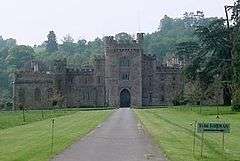Hampton Court, Herefordshire
| Hampton Court | |
|---|---|
 Hampton Court seen from North | |
 Location in Herefordshire | |
| Alternative names | Hampton Court Castle |
| General information | |
| Architectural style | Gothic, Gothic Revival |
| Location | Hope under Dinmore, England |
| Coordinates | 52°10′3.57″N 2°42′14.91″W / 52.1676583°N 2.7041417°WCoordinates: 52°10′3.57″N 2°42′14.91″W / 52.1676583°N 2.7041417°W |
| Construction started | 1427 |
Hampton Court is a castellated country house in the English county of Herefordshire. The house is located in the village of Hope under Dinmore, near Leominster and is a Grade I listed building.[1]
History
Hampton Court dates from 1427, when a Sir Rowland Lenthall built the original house on an estate which had been granted to him some years previously by King Henry IV on the occasion of his marriage to the king's cousin Margaret Fitzalan, a daughter of the Earl of Arundel. Sir Rowland's house was a quadrangular courtyard house, and despite numerous alterations over the centuries the house has retained this basic form.
Construction of the house had actually started under Henry Bolingbroke, as Henry IV was at the time, before he gave it to Lenthall.[2]
Successive owners
It was owned by the Coningsby family from 1510 until the early 19th century when the estate was purchased by John Arkwright, the grandson of the inventor and industrialist Richard Arkwright.
Some of the original oak panelling was removed, probably during the 17th century, to the private house Wickton Court near Leominster (grid SO525500) where it still adorns the living room.
The house was remodelled in the 1830s and 1840s to give it more of a castle air, reversing earlier attempts to make it appear more regular and domestic.
It was sold by John Stanhope Arkwright in 1910 and has since changed hands several more times. Between 1924 and 1972 it was the seat of Viscount Hereford and was bought by American businessman Robert Van Kampen in 1994. He died in 1999. The formal gardens were still opened with a celebration by the Van Kampen family in the year 2000, where the Indiana Wesleyan University Chorale was featured as a sacred choir and some members as a small madrigal choir.
Hampton Court Castle and grounds were sold by the Van Kampen family in 2008. As of 2014, it is again for sale for £16M. [3]
In January 2016, the house was for sale at the price of £12M. It was described as part of a 935-acre property with 26 bedrooms and 25 bathrooms. It also includes a conservatory designed by Joseph Paxton.[2]
Gardens

The gardens are a particular feature, and include an organically managed kitchen garden, as well as a maze, a secret tunnel, Dutch garden, island pavilions and a 150-year-old wisteria arch.
Hampton Court has a twelve acre garden which was largely created by the Van Kampens and is open to the public throughout the summer months, and now offers special events such as outdoor theatre productions, concerts and family days out.
The house featured extensively in the 1970s BBC TV Series Survivors: large parts of the first series were filmed in and around the house in spring and summer of 1975. The house was empty at the time.
References
- ↑ Historic England. "Hampton Court, Herefordshire (1157291)". National Heritage List for England. Retrieved 24 October 2013.
- 1 2 Doyle, Jessica (16 January 2016). "Hot property- castles". Financial Times. House & Home. p. 10.
- ↑ "World's most covetable castles for sale". Daily Telegraph.
External links
- Official site
- Hampton Court section of Sola Scriptorum's site
- Photos of Hampton Court and surrounding area on geograph.org.uk
| Wikimedia Commons has media related to Hampton Court, Herefordshire. |